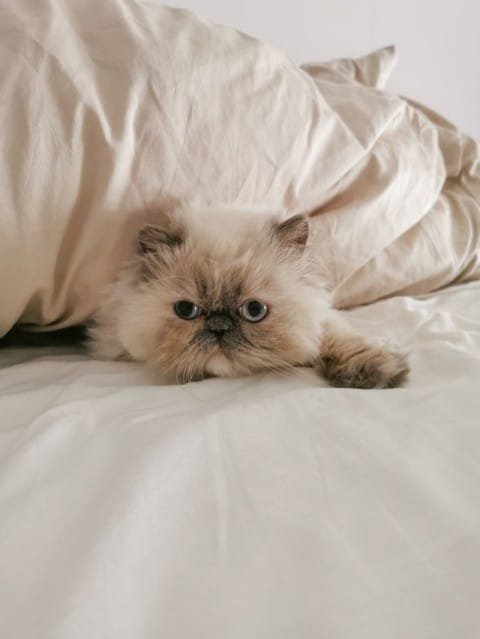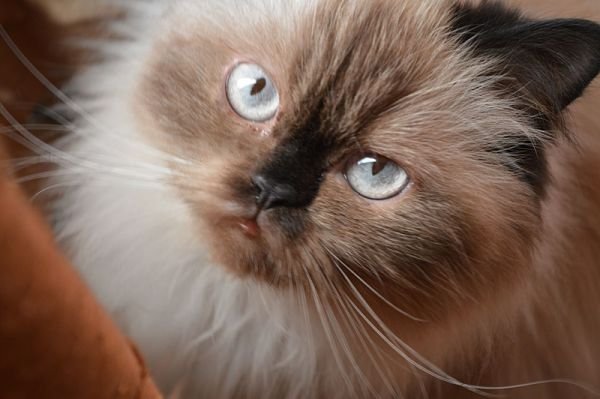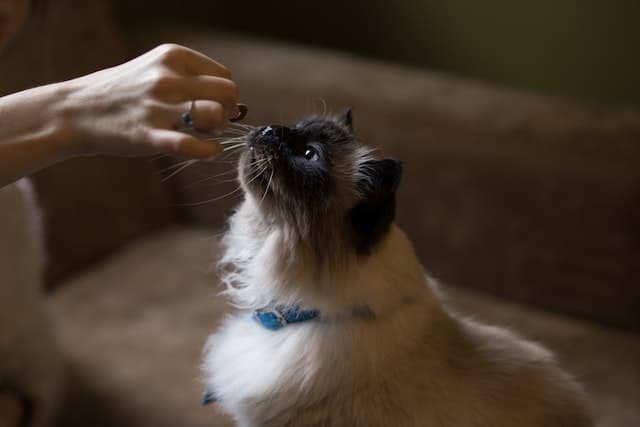Persian and Siamese cats are among the most popular cat breeds in the world. It was expected that one day, cat breeders would crossbreed these two cats. Eventually, that happened, and as a result, we got the Himalayan cat breed.
There is still a dispute going on about whether Himalayan cats should be considered a separate breed or if they are just a subtype of Persian cats. Either way, they are great pets, and they certainly deserve more attention and praise. Keep reading to learn more!
Himalayan Cat Characteristics
Appearance
| Fur color | All colors are allowed as long as there is a contrast between body and face. |
| Fur pattern | Color-point |
| Fur length | Long |
| Eye color & shape | Large, round, and widely set apart that can be any shade of blue |
| Length | Males 17”-19” Females 15”-17” |
| Weight | Males 7-12 lbs Females 5-10 lbs |
| Expected lifespan | 9-15 years |
Personality
| Temperament | Playful but gentle, calm, even-tempered, devoted, affectionate, sweet, loving, and docile. |
| Kids and other pets | Friendly towards children and other pets. |
| Sociable and cuddly | Extremely sociable and cuddly |
Requirements & Traits
| Feeding | Meat-based foods rich in protein. Kittens should eat 3-4 times a day, while adults should eat 2-3 times a day. |
| Grooming | Brushing the fur at least once a week with occasional trimming. Nail trimming and dental hygiene are also important. |
| Shedding | Moderate |
| Hypoallergenic | No |
History and Origins

The first deliberate pairing of Persian and Siamese cats happened in 1925, and it was carried out by a Swedish geneticist. In the coming years, these pairings were repeated, but not because of the desire to create a new breed. Instead, Persian and Siamese cats were paired to explore the inheriting mechanisms of certain characteristics.
Since long furs and color point fur patterns are recessive characteristics, these pairings produced shorthaired kittens without color point fur patterns. For a long fur and color point pattern to present themselves, both parents had to carry the genes responsible for those traits.
When An Experiment Grows into Something More
The breeders had to become creative if they wanted to produce a litter of kittens that would have long furs and color-point fur patterns. Two Harvard medical researchers came up with a brilliant strategy in the 1930s.
First, they paired a Siamese female cat with a black Persian tomcat. That pairing produced a litter of black shorthaired kittens. Then, they paired a black Persian female cat and a Siamese tomcat. That pairing produced a similar litter full of black shorthaired kittens.
Finally, these two scientists paired a female cat from the second litter with a tomcat from the first litter. A cat named Debutante was born, and it had a Siamese body build and color point fur pattern, and its fur was as long, just like in Persian cats.
A Birth Of A New Breed
This piqued the interest of both American and British cat breeders, and they all tried to produce long-haired cats that would have color-point fur patterns. However, WW2 started and stopped those efforts for some time.
In 1950, American breeder Marguerita Goforth finally created a Persian-like color-point cat. Seven years later, CFA recognized these cats as a new breed named Himalayan. By 1961, other major US cat associations recognized Himalayans.
However, in more recent times, some cat associations started incorporating Himalayan cats into the Persian breed. This is due to the fact that Himalayans are still outcrossed with Persians, and the resulting offspring can be considered either Himalayan or Persian, depending on their appearance.
Himalayan Cat Personality
Himalayans inherited most of their personality traits from Persian cats. They are gentle, sweet, quiet, even-tempered, undemanding, docile, cuddly, and affectionate, just like Persians. Still, Himalayan cats have inherited a spark of Siamese personality. They are playful cats, and while they will spend most of their day just chilling, they will also show some sudden outbursts of energy.
Himalayan cats like to be around their owners, and they don’t like being left alone. These cats thrive on attention and affection. They are extremely friendly, even towards children, other pets, and strangers.
Himalayan Cat Appearance
For several years, breeders have tried to produce cats that will look like color point Persians, and Himalayan cats were a result of such efforts. Their appearance is truly unique and beautiful, so let’s take a look at Himalayan’s defining traits.

Fur
The unique furs are certainly the most distinctive physical trait of Himalayan cats. They are long and thick with dense undercoats. The fur thickness and even length can vary depending on the season, as the fur thickens right before the winter. Then, when the winter ends and the warmer weather arrives, the Himalayans shed some of their furs to prepare for higher temperatures.
If you live in an area with colder climate, it should be no surprise that Himalayan cats thrive in colder weather.
The Himalayan fur can be of any color possible for color-point cats. There should be a visible contrast between the body and color point color. The face, ears, legs, paws, and tail are darker, while the rest of the body should be of lighter color.
Eyes
Himalayan cats have large and round eyes that are widely set apart and expressive. The only allowed eye color for Himalayan cats is blue, and deep blue eyes are especially prized. Still, light or medium blue eyes are also acceptable.
Size
Just like their ancestors, Persian and Siamese cats, Himalayan cats are also medium-sized. Males are larger than females, and they usually weigh between 7 and 12 pounds. Their body length ranges between 17 and 19 inches.
Female Himalayan cats usually weigh between 5 and 10 pounds, and their body length ranges between 15 and 17 inches.
Other Body Characteristics
Himalayan’s body is stocky, firm, and well-rounded. The chest area is deep and rounded. This is a muscular, sturdy, and heavy-boned breed. The legs are sturdy, muscular, and well-developed. Hind legs are longer than the front legs. The paws are large and round. The tail is short and straight in proportion to the rest of the body.
The head is round and wide. It is medium-sized and proportionate to the rest of the body. The cheeks are full, the jaw is prominent, the muzzle is broad, and the chin is strong and well-developed. The neck is short, thick, and muscular. The ears are widely set apart, small, and rounded.
Daily Life With Himalayan Cat
For a long-haired breed, Himalayan cats are relatively undemanding. Of course, with every cat breed, there are some basic requirements that you, as the owner, will have to fulfill. That’s just the reality of owning a cat, and once you get into a routine, you will see that it is not so hard to meet your cat’s needs.
Feeding

All cats are obligate carnivores, which means they shouldn’t eat anything that’s not meat. This includes not only fruits, vegetables, sweets, and bread but also eggs and dairy products. Many people give milk to their cats, but the truth is cats have no need for milk once they stop nursing. Additionally, some cats are lactose-intolerant, so make sure to feed your Himalayan cat with meat only.
Fortunately, there are many high-quality commercial cat foods on the market. These foods can be either wet or dry, and both options come with some benefits. Wet cat food is good for keeping your cat hydrated, while dry food will keep your cat’s teeth healthy. Cats usually prefer wet food, but dry food has a longer shelf life.
Himalayan kittens need to eat more often than adult cats because they need more energy to sustain growth. Those kittens need to eat 3-4 times a day, while adult Himalayans need to eat 2-3 times a day. The exact portion size and feeding frequency should be determined by your vet.
You can treat your Himalayan cat with some occasional snacks. Finally, make sure your cat has free access to fresh drinking water.
Grooming
Himalayan cats have long, dense furs that need to be brushed regularly in order to remove loose hairs, prevent matting, and distribute oils from the skin. Brushing the fur once or twice enough per week will be enough. Some Himalayan breeders recommend occasional baths to help remove excess oils from skin and fur.
Speaking of fur, use a wet cloth or paper towel to clear tear stains from your Himalayan’s face. Gently use the cloth to clean the ears when needed.
Trim your Himalayan cat’s nails every two weeks. Dental hygiene is also important as it can prevent many dental issues down the road. If you can’t make your Himalayan put up with nail trimming and teeth brushing, take it to the pet groomer and offer some teeth-cleaning snacks.
Activity
Himalayans are moderately playful cats that will have occasional outbursts of energy. Apart from that, Himalayan cats are just like Persians, docile, calm, and quiet. They prefer laying somewhere cozy over running and jumping around.
This is great for cat owners that can’t deal with an active cat. However, this doesn’t mean that your Himalayan cat needs no activity or playtime. Enough exercise is important for your cat’s physical and mental health.
Provide your Himalayan with some toys, a cat scratching tree, and a cat climbing tree. Spend some time every day playing with your Himalayan cat, and when none of you feel like playing, you can still cuddle. Your Himalayan will love it!
Himalayan cats are indoor cats, and I don’t recommend you let them play outside. You can try taking them for a walk or a jog, but don’t expect to run/walk a marathon.
Most Common Himalayan Cat Health Issues
Himalayan cats are generally healthy, and they often live long and healthy lives. Still, every cat can become ill regardless of its breed. Let’s take a closer look at some of the most common conditions that affect Himalayan cats.

Brachycephaly
Since Himalayan cats are direct descendants of Persian cats, they often have flat faces, just like Persians. Technically, brachycephaly is not a condition per se; it is a medical term for flat-faced animals, including cats and dogs.
Brachycephalic cats experience various breathing difficulties, dental malocclusions, and an eye condition called “cherry eye.” If your Himalayan is flat-faced, take it to the vet for regular checks. The vet will be able to determine whether your cat’s brachycephaly is causing some discomfort, and they will come up with appropriate treatment.
Polycystic Kidney Disease
Himalayan cats also have genetic predispositions for developing polycystic kidney disease. This condition is characterized by the formation of multiple cysts on the cat’s kidneys. The affected kidneys become enlarged, inflamed, and less effective. Eventually, polycystic kidney disease can cause kidney failure and death.
Some common symptoms of polycystic kidney disease are increased thirst and frequent urination, loss of appetite, weight loss, vomiting, abdominal swelling, lethargy, weakness, bad breath, etc.
I said this sentence so many times, but if you notice any of these symptoms, you need to take your cat to the vet. This disease can be treated and managed through medication and dietary changes. The vet will determine which course of action will be the most beneficial for your cat’s recovery.
Obesity
Many indoor cats are obese due to lack of activity and constant food access. Himalayans are no different, and since they inherited the docility and laziness of Persian cats, they are at higher risk of becoming obese.
The problem with obesity isn’t its effect on aesthetics; it is much deeper and more serious. Obesity causes many other health conditions that can significantly lower your cat’s life quality, and some of them are even life-threatening. The list of obesity-caused diseases is long, and it includes diabetes, arthritis, cardiovascular issues, breathing problems, etc.
If you notice your cat is much heavier than it is normal for Himalayan cats, or if you notice it has gained a lot of weight recently, take it to the vet. The vet will be able to come up with a dietary and exercise plan that will help your cat lose weight in the healthiest way possible.
Feline Lower Urinary Tract Disease
Himalayan cats can also suffer from lower urinary tract disease, a condition that refers to a number of conditions of the bladder and urethra, including bladder stones, urinary tract infections, and urethra blockages.
The most common symptoms include increased or strained urination, blood in the urine, loss of appetite, lethargy, fever, etc. If you notice any of these symptoms, take your cat to the vet. There, your cat will receive a treatment that’s the most appropriate for its condition. Some of the possible treatments include medications, dietary changes, and surgery in more severe cases.
Progressive Retinal Atrophy
This condition is actually a group of genetic eye conditions that cause the deterioration of the retina. The retina is a part of the eye that’s responsible for receiving images and sending them to the brain in the form of electric signals.
With progressive retinal atrophy, the retina deteriorates over time, and as a result, the cat is going through a gradual vision loss. Some of the warning signs that your cat is suffering from progressive retinal atrophy are night blindness and impaired vision.
Progressive retinal atrophy can’t be cured, but it can be slowed down. This is why you should take your cat to regular vet checkups to prevent any further damage and to increase your cat’s life quality.
Himalayan Cat Name Suggestions
Even though Himalayan cats don’t really come from Himalaya, I think it would be interesting to give this cat a name associated with this glorious mountain range. Let’s take a look at some cool ideas:
- Everest
- Nepal
- Snowball
- Frost
- Snowflake
- Diamond
- Aurora
- Saphire
- Ruby
- Amrita
Buying or Adopting Himalayan Cat
Himalayan cats are relatively common in the US, so it shouldn’t be too hard to find one in adoption shelter. The adoption fee will cost you $75-$150.
If you decide to buy your Himalayan cat from a breeder, it will cost you between $1000 and $2500, depending on its age, gender, and physical traits. Make sure to buy cats from reputable breeders only. A reputable breeder should be ready to provide you with a health certificate that confirms that your cat has no underlying health conditions
Frequently Asked Questions
Yes, Himalayan cats are good pets. They are gentle, calm, docile, and quiet.
No, Himalayan cats are fairly common in the US.
Just like their ancestors, Persians, Himalayan cats are quiet and not as talkative as some other breeds. However, keep in mind that this can vary, depending on the cat.
Since Himalayan cats have such thick and long furs, it is recommended that you give them a bath at least every few months.
You shouldn’t give your Himalayan cat any dairy products, including milk. Most cats are lactose intolerant, and feeding them milk can cause discomfort and health issues.
Himalayan Cat Fun Facts
- Although their name hints at Himalayan or Nepal origins, Himalayan cats actually originated in the US. They got the name “Himalayan” because they have the same fur pattern as some Himalayan animals, such as the Himalayan snow leopard and Himalayan rabbit.
- Himalayan cats are also called “Himmies” by their owners and breeders.
- In the 90s, Martha Stewart had three Himalayan cats named Beethoven, Mozart, and Bartok. These cats even appeared in her commercials, TV shows, and in her magazine.
Himalayan Cat Alternatives
Do you want a cat that looks like a Himalayan cat, but you can’t buy Himalayan for some reason? Since Himalayans are direct descendants of Persian and Siamese cats, these two breeds can be bought as an alternative to the Himalayan cat.
Other breeds that share some similar traits with a Himalayan breed are Turkish Angora, Exotic Shorthair, Burmese, and Ragdoll cats. With so many options at your disposal, I am certain you will find something perfect for you.
Summary
Himalayan cats are a recent breed, but their origin story is really fascinating. This breed is one of the most beautiful breeds in the world, and its personality certainly matches its appearance. Himalayans are affectionate, loyal, sweet, gentle, and well-mannered cats.
If this sounds appealing (of course it does) to you, you should definitely consider getting a Himalayan cat. You will never regret it!
